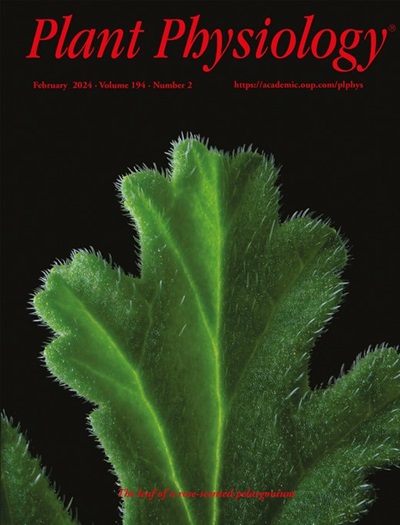BTB/POZ-MATH proteins regulate Arabidopsis seedling development by promoting auxin-independent degradation of the Aux/IAA protein IAA10
IF 6.5
1区 生物学
Q1 PLANT SCIENCES
引用次数: 0
Abstract
After germination, seedlings undergo etiolated development (skotomorphogenesis), enabling them to grow toward the soil surface. In Arabidopsis (Arabidopsis thaliana), etiolated seedlings exhibit rapid hypocotyl elongation, apical hook formation, and closed cotyledons to protect the meristem. In this study, we found that high-order mutants in the BPM (BTB/POZ-MATH) gene family displayed defects in seedling development, characterized by a shorter hypocotyl, early apical hook opening, and opened cotyledons in the dark. BPM1, BPM2, BPM4, and BPM5 exhibited distinct expression patterns and subcellular localization in etiolated seedlings. In a hypocotyl segment assay, the bpm mutants showed defects in auxin response, indicating impaired auxin signaling in the hypocotyl. Expression of the auxin reporter DR5:GFP was also altered in the bpm1,4,5 mutant in various tissues compared to the wild type. Furthermore, yeast two-hybrid, bimolecular fluorescence complementation (BiFC), and co-immunoprecipitation (Co-IP) assay analyses showed that BPM1 interacts with IAA10. Experiments in protoplasts indicated that BPM1 promotes IAA10 ubiquitylation and degradation, which was supported by greater IAA10 protein accumulation in the bpm1,4,5 mutant background. In addition, IAA10 over-expression resulted in phenotypes similar to those of the bpm mutants, indicating that the BPMs may target the Aux/IAA proteins for ubiquitylation and degradation. Overall, our findings shed light on the key roles of the BPMs in auxin signaling during seedling development.BTB/POZ-MATH蛋白通过促进Aux/IAA蛋白IAA10的生长素非依赖性降解来调节拟南芥幼苗发育
萌芽后,幼苗会经历去叶发育(skotomorphogenesis),使其能够向土壤表面生长。在拟南芥(Arabidopsis thaliana)中,经过叶化的幼苗表现出快速的下胚轴伸长、顶端钩的形成以及闭合子叶以保护分生组织。在这项研究中,我们发现 BPM(BTB/POZ-MATH)基因家族的高阶突变体在幼苗发育中表现出缺陷,其特征是下胚轴较短、顶端钩打开较早、子叶在黑暗中打开。BPM1、BPM2、BPM4 和 BPM5 在黄化幼苗中表现出不同的表达模式和亚细胞定位。在下胚轴区段测定中,BPM突变体表现出对辅素反应的缺陷,表明下胚轴中的辅素信号转导受损。与野生型相比,bpm1,4,5 突变体各组织中的辅助素报告基因 DR5:GFP 的表达也发生了改变。此外,酵母双杂交、双分子荧光互补(BiFC)和共免疫沉淀(Co-IP)分析表明,BPM1 与 IAA10 相互作用。原生质体中的实验表明,BPM1 促进了 IAA10 的泛素化和降解,这一点在 bpm1,4,5 突变体背景中得到了证实。此外,IAA10的过度表达也导致了与bpm突变体相似的表型,这表明BPM可能以Aux/IAA蛋白为目标进行泛素化和降解。总之,我们的发现揭示了 BPM 在幼苗发育过程中辅助素信号转导的关键作用。
本文章由计算机程序翻译,如有差异,请以英文原文为准。
求助全文
约1分钟内获得全文
求助全文
来源期刊

Plant Physiology
生物-植物科学
CiteScore
12.20
自引率
5.40%
发文量
535
审稿时长
2.3 months
期刊介绍:
Plant Physiology® is a distinguished and highly respected journal with a rich history dating back to its establishment in 1926. It stands as a leading international publication in the field of plant biology, covering a comprehensive range of topics from the molecular and structural aspects of plant life to systems biology and ecophysiology. Recognized as the most highly cited journal in plant sciences, Plant Physiology® is a testament to its commitment to excellence and the dissemination of groundbreaking research.
As the official publication of the American Society of Plant Biologists, Plant Physiology® upholds rigorous peer-review standards, ensuring that the scientific community receives the highest quality research. The journal releases 12 issues annually, providing a steady stream of new findings and insights to its readership.
 求助内容:
求助内容: 应助结果提醒方式:
应助结果提醒方式:


